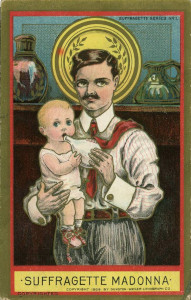Exhibits > Voting for Women > Opposition
Opposition

“Suffragette Madonna” postcard, circa 1909, Dunston-Weiler Lithograph Company, The Suffrage Postcard Project.
A major pandemic rages. Police and security forces attack worker- and union-led challenges to capitalist power structures. White supremacists use actual and media-portrayed violence to reinforce the oppression of Black people. Is this 1920 or 2020?
Significant cultural upheaval defines both the past and present eras, centering around how inclusive American culture would, or could, be. Inclusivity asserts that rights are not granted, but inherent. It is the responsibility of power structures to remove barriers that prevent equal participation by all in whatever activities or roles they pursue. Building an inclusive culture requires change. Change is not always easy or welcome, and that was certainly the case with suffrage, both in Oregon and in the United States.
Five times between 1872 and 1910, Oregon men voted against allowing their fellow citizens to vote. Their opposition followed regular channels — women were not intellectually or emotionally up to the rigors of voting; voting women would force men to perform “women’s work;” the natural societal order would be disturbed, causing economic, cultural and familial damage.
Progressive coalitions, mass advertising, engaging speakers and writers, and a distancing from the Prohibition movement convinced voters in 1912 to remove gender qualifications from voting. National suffrage followed eight years later. By 1929, on the eve of the Great Depression, women represented 46.5 percent of registered voters and were members of ten political parties.
<<Previous: Suffrage and Prohibition | Next: More Work Remains>>

